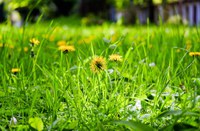Dakota Gardener: The messy and controversial science behind No Mow May
(Click an image below to view a high-resolution image that can be downloaded)
By Esther E. McGinnis, Horticulturist
NDSU Extension
No Mow May is a popular conservation movement to encourage people to abstain from mowing their lawns during the month of May. The stated purpose is to allow weeds to grow and flower in the lawn to provide nectar and pollen to nourish early season pollinators such as bees and butterflies.
People are surprised that NDSU Extension isn’t promoting this practice. Our organization normally encourages pollinator-friendly conservation practices. However, No Mow May lacks scientific support and is even considered controversial.
No Mow May is a British pollinator movement that was embraced by the town of Appleton, Wisconsin. Numerous Wisconsin residents pledged to forego spring mowing. Seeing an opportunity, Lawrence University researchers decided to study this phenomenon. The researchers compared the pollinator species diversity and abundance between unmowed residential lawns and mowed park land. They published a study showing that unmowed residential lawns attracted more bee species and larger quantities compared to the mowed park land.
The Lawrence University research study was published and received a huge amount of national press including an article in the New York Times. Consequently, many communities across the country adopted No Mow May.
Then an unexpected development occurred. On November 18, 2022, the original research study was retracted due to “several potential inconsistencies in data handling and reporting.”
Scientific journals rarely retract articles that have been published.
Admittedly, I had my doubts on No Mow May for other reasons. I frequently lecture on turfgrass management practices and was concerned that foregoing mowing for an entire month would damage lawns right before summer.
One important rule of thumb for growing healthy lawns is to never trim off more than 1/3 the height of your turfgrass at one time. For example, if you allow your lawn to grow 4.5 inches tall, the maximum length that can be removed at one time is 1.5 inches leaving a 3-inch tall lawn.
No Mow May violates this rule because lawns may grow 12 inches or more during the month. Trimming a 15-inch lawn down to 3 inches on June 1 shocks the turfgrass plants. Even worse, this stress is imposed right before summer and therefore, the lawn is less able to handle heat and drought.
A second concern is that few homeowners have mower equipment that can handle tall grass. Consequently, deep swaths of “hay” will be left on the lawn when homeowners mow in June. Excessively long clippings may smother the lawn and will need to be raked up thereby depriving the lawn of the nutrients from the clippings.
A final concern is that No Mow May mostly results in blooming dandelions. Yes, many pollinator species visit dandelions for their nectar. However, recent research has shown that dandelion pollen is deficient in important amino acids.
If you want to support pollinator conservation, there are better methods for doing so. Consider installing a pollinator garden using nectar- and pollen-rich plants. Plant spring flowering trees and shrubs. If you want to make your lawn more sustainable, consider planting a bee lawn that includes Dutch white clover.
For more information on pollinator-friendly practices, please visit the NDSU Extension Pollinator Conservation Facebook page.
NDSU Agriculture Communication – May 24, 2023
Source: Esther McGinnis, 701-231-7406, esther.mcginnis@ndsu.edu
Editor: Kelli Anderson, 701-231-6136, kelli.c.anderson@ndsu.edu




